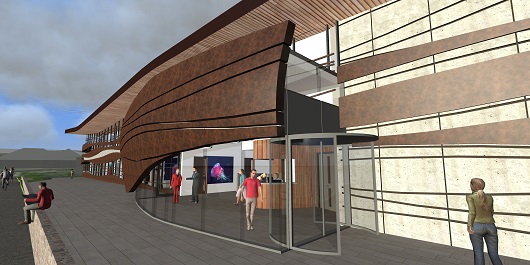New £10m marine lab for St Andrews

A new £10 million marine laboratory planned for the University of St Andrews will help cement Scotland’s reputation as a world leader in oceanic research and species protection.
The University is to build the state of the art marine biology lab at East Sands in St Andrews, replacing the internationally renowned but now outdated Gatty Marine facility.
St Andrews has commissioned designs for a new 2,256 square metre research building and a ‘smart’ aquarium that will be the most technologically advanced in the UK.
The new facility will provide a global hub for marine research focused on conservation and understanding the effects of climate change on the world’s oceans.
It will be the permanent base of the Scottish Oceans Institute which includes the world leading Sea Mammal Research Unit, and the executive office of the Marine Alliance for Science and Technology for Scotland (MASTS).
The modern marine biological research being undertaken at St Andrews exploits advances in remote sensing, DNA technology, microscopy and analytical capabilities that rely on a new kind of aquarium.
The new aquarium will cater for extensive environmental monitoring and control of temperature, lighting, pH, oxygen, salinity, ammonia and nitrates.
Specialist rooms with climate control will allow electronic and optical equipment to co-exist with culture facilities supplied with running seawater.
This will support sophisticated long-term experiments on adaptation of organisms to climate change.
The building will also incorporate a Public Outreach Centre, taking advantage of its location on the Fife Coastal Path, allowing St Andrews to play a lead role in furthering public interest in and understanding of the oceans and the unique ecosystem of the North Sea.
Professor Garry Taylor, Acting Principal at St Andrews, said, “The rebuilding of the Gatty is a high priority in our strategic plan. Marine research has taken place here for over 100 years, but its potential has now substantially outgrown the reality of its present facilities.
“By investing in a new state of the art facility, we are investing in the highest quality of international marine research and the reputation of St Andrews and Scotland as leaders and pioneers in this increasingly important branch of science.”
The marine research carried out at St Andrews was rated to have the highest impact of all marine research in the UK in the last Research Excellence Framework assessment published in 2014.
Key projects include:
Animal-borne telemetry tags for conservation and weather forecasting
The Sea Mammal Research Unit (SMRU) Instrumentation Group has designed, built and supplied about 400 telemetry tags per year since 2008, which have generated over £7 million in the UK and abroad. The tags inform decisions on the conservation of species as well as contributing to improved ocean circulation models and weather forecasting.
Tags have enabled national agencies in 15 countries to build their knowledge of endangered or threatened species, such as the Monk seal and Steller Sea Lion, and allow judgments to be made about the regulation of offshore industrial developments.
Conservation
The St Andrews Sea Mammal Research Unit has developed new techniques to support marine mammal conservation, including “sparse data sampling” which gives robust estimates of marine mammal population density and distribution, and telemetry tagging which allows individual animal behaviour and movements to be logged and recovered via satellite or mobile phone.
SMRU’s research has been instrumental in the development of policy on marine mammal conservation, placing legal obligations on EU Member states to assess and report on the conservation status of their marine mammal populations.
In the Moray Firth, seals had been shot due to the perception that they impacted on salmon stocks, and thus the local economy. SMRU’s research led to legislation protecting seals – part of the Marine (Scotland) Act 2010 – and resulted in a 60% reduction in seal shooting in the Moray Firth area.
The bycatch of marine mammals in fisheries is a major threat to their conservation. SMRU has implemented an observer scheme on UK fishing boats to quantify bycatch and has helped to implement specific acoustic deterrent devices. As a result, the pair-trawl bass fishery in the English Channel has seen a reduction in cetacean bycatch. This work and connected public outreach was awarded the Queen’s Anniversary Prize in 2011 for excellence in research supporting better governance of the ocean.
Protecting the future of the oceans
Work carried out at St Andrews has led to the establishment of over 107 internationally important sites of Marine Special Areas of Conservation and Marine Special Protection Areas. Sonar methods pioneered by St Andrews scientists have become part of internationally adopted practice, for example on fisheries protection sites.
Other applications have been in the study of rapidly retreating glaciers and areas of sea-ice melt in Greenland, habitats to some of our most threatened species, such as the polar bear. This research was highlighted in the award-winning 2012 BBC programme, Operation Iceberg.
The University is currently fundraising to support the new labs and is in discussion with potential major partners. It will apply for planning permission for the development early this year.
Issued by the Press Office, University of St Andrews
Contact Gayle Cook via [email protected] or tel 01334 462530 / 467227
Ref: New Gatty 060116
Category Research